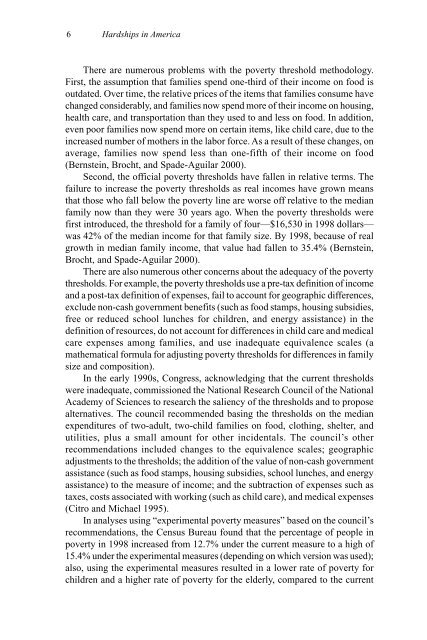You also want an ePaper? Increase the reach of your titles
YUMPU automatically turns print PDFs into web optimized ePapers that Google loves.
6 Hardships in America<br />
There are numerous problems with the poverty threshold methodology.<br />
First, the <strong>as</strong>sumption that families spend one-third of their income on food is<br />
outdated. Over time, the relative prices of the items that families consume have<br />
changed considerably, and families now spend more of their income on housing,<br />
health care, and transportation than they used to and less on food. In addition,<br />
even poor families now spend more on certain items, like child care, due to the<br />
incre<strong>as</strong>ed number of mothers in the labor force. As a result of these changes, on<br />
average, families now spend less than one-fifth of their income on food<br />
(Bernstein, Brocht, and Spade-Aguilar 2000).<br />
Second, the official poverty thresholds have fallen in relative terms. The<br />
failure to incre<strong>as</strong>e the poverty thresholds <strong>as</strong> real incomes have grown means<br />
that those who fall below the poverty line are worse off relative to the median<br />
family now than they were 30 years ago. When the poverty thresholds were<br />
first introduced, the threshold for a family of four—$16,530 in 1998 dollars—<br />
w<strong>as</strong> 42% of the median income for that family size. By 1998, because of real<br />
growth in median family income, that value had fallen to 35.4% (Bernstein,<br />
Brocht, and Spade-Aguilar 2000).<br />
There are also numerous other concerns about the adequacy of the poverty<br />
thresholds. For example, the poverty thresholds use a pre-tax definition of income<br />
and a post-tax definition of expenses, fail to account for geographic differences,<br />
exclude non-c<strong>as</strong>h government benefits (such <strong>as</strong> food stamps, housing subsidies,<br />
free or reduced school lunches for children, and energy <strong>as</strong>sistance) in the<br />
definition of resources, do not account for differences in child care and medical<br />
care expenses among families, and use inadequate equivalence scales (a<br />
mathematical formula for adjusting poverty thresholds for differences in family<br />
size and composition).<br />
In the early 1990s, Congress, acknowledging that the current thresholds<br />
were inadequate, commissioned the National Research Council of the National<br />
Academy of Sciences to research the saliency of the thresholds and to propose<br />
alternatives. The council recommended b<strong>as</strong>ing the thresholds on the median<br />
expenditures of two-adult, two-child families on food, clothing, shelter, and<br />
utilities, plus a small amount for other incidentals. The council’s other<br />
recommendations included changes to the equivalence scales; geographic<br />
adjustments to the thresholds; the addition of the value of non-c<strong>as</strong>h government<br />
<strong>as</strong>sistance (such <strong>as</strong> food stamps, housing subsidies, school lunches, and energy<br />
<strong>as</strong>sistance) to the me<strong>as</strong>ure of income; and the subtraction of expenses such <strong>as</strong><br />
taxes, costs <strong>as</strong>sociated with working (such <strong>as</strong> child care), and medical expenses<br />
(Citro and Michael 1995).<br />
In analyses using “experimental poverty me<strong>as</strong>ures” b<strong>as</strong>ed on the council’s<br />
recommendations, the Census Bureau found that the percentage of people in<br />
poverty in 1998 incre<strong>as</strong>ed from 12.7% under the current me<strong>as</strong>ure to a high of<br />
15.4% under the experimental me<strong>as</strong>ures (depending on which version w<strong>as</strong> used);<br />
also, using the experimental me<strong>as</strong>ures resulted in a lower rate of poverty for<br />
children and a higher rate of poverty for the elderly, compared to the current



